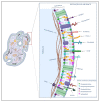Platelet Membrane: An Outstanding Factor in Cancer Metastasis
- PMID: 35207103
- PMCID: PMC8875259
- DOI: 10.3390/membranes12020182
Platelet Membrane: An Outstanding Factor in Cancer Metastasis
Abstract
In addition to being biological barriers where the internalization or release of biomolecules is decided, cell membranes are contact structures between the interior and exterior of the cell. Here, the processes of cell signaling mediated by receptors, ions, hormones, cytokines, enzymes, growth factors, extracellular matrix (ECM), and vesicles begin. They triggering several responses from the cell membrane that include rearranging its components according to the immediate needs of the cell, for example, in the membrane of platelets, the formation of filopodia and lamellipodia as a tissue repair response. In cancer, the cancer cells must adapt to the new tumor microenvironment (TME) and acquire capacities in the cell membrane to transform their shape, such as in the case of epithelial-mesenchymal transition (EMT) in the metastatic process. The cancer cells must also attract allies in this challenging process, such as platelets, fibroblasts associated with cancer (CAF), stromal cells, adipocytes, and the extracellular matrix itself, which limits tumor growth. The platelets are enucleated cells with fairly interesting growth factors, proangiogenic factors, cytokines, mRNA, and proteins, which support the development of a tumor microenvironment and support the metastatic process. This review will discuss the different actions that platelet membranes and cancer cell membranes carry out during their relationship in the tumor microenvironment and metastasis.
Keywords: cancer cell membrane; microenvironment; platelet membrane; receptors.
Conflict of interest statement
The authors declare no conflict of interest.
Figures



Similar articles
-
Tumor Microenvironment and Nitric Oxide: Concepts and Mechanisms.Adv Exp Med Biol. 2020;1277:143-158. doi: 10.1007/978-3-030-50224-9_10. Adv Exp Med Biol. 2020. PMID: 33119871
-
Tumor microenvironment and noncoding RNAs as co-drivers of epithelial-mesenchymal transition and cancer metastasis.Dev Dyn. 2018 Mar;247(3):405-431. doi: 10.1002/dvdy.24548. Epub 2017 Sep 18. Dev Dyn. 2018. PMID: 28691356 Review.
-
Matrix Metalloproteinases' Role in Tumor Microenvironment.Adv Exp Med Biol. 2020;1245:97-131. doi: 10.1007/978-3-030-40146-7_5. Adv Exp Med Biol. 2020. PMID: 32266655 Review.
-
Cancer metastases: challenges and opportunities.Acta Pharm Sin B. 2015 Sep;5(5):402-18. doi: 10.1016/j.apsb.2015.07.005. Epub 2015 Sep 8. Acta Pharm Sin B. 2015. PMID: 26579471 Free PMC article. Review.
-
The tumor microenvironment: An irreplaceable element of tumor budding and epithelial-mesenchymal transition-mediated cancer metastasis.Cell Adh Migr. 2016 Jul 3;10(4):434-46. doi: 10.1080/19336918.2015.1129481. Epub 2016 Jan 8. Cell Adh Migr. 2016. PMID: 26743180 Free PMC article. Review.
Cited by
-
Platelet-Rich Plasma in Dermatology: New Insights on the Cellular Mechanism of Skin Repair and Regeneration.Life (Basel). 2023 Dec 25;14(1):40. doi: 10.3390/life14010040. Life (Basel). 2023. PMID: 38255655 Free PMC article. Review.
-
Biomarkers predicting the efficacy of immune checkpoint inhibitors in hepatocellular carcinoma.Front Immunol. 2023 Dec 22;14:1326097. doi: 10.3389/fimmu.2023.1326097. eCollection 2023. Front Immunol. 2023. PMID: 38187399 Free PMC article. Review.
-
Advanced development of biomarkers for immunotherapy in hepatocellular carcinoma.Front Oncol. 2023 Jan 16;12:1091088. doi: 10.3389/fonc.2022.1091088. eCollection 2022. Front Oncol. 2023. PMID: 36727075 Free PMC article. Review.
-
Molecular Mechanism of Cellular Membranes for Signal Transduction.Membranes (Basel). 2022 Jul 30;12(8):748. doi: 10.3390/membranes12080748. Membranes (Basel). 2022. PMID: 36005663 Free PMC article.
-
Visualization of Cellular Membranes in 2D and 3D Conditions Using a New Fluorescent Dithienothiophene S,S-Dioxide Derivative.Int J Mol Sci. 2023 Jun 1;24(11):9620. doi: 10.3390/ijms24119620. Int J Mol Sci. 2023. PMID: 37298572 Free PMC article.
References
-
- Escribá P.V., González-Ros J.M., Goñi F.M., Kinnunen P.K.J., Vigh L., Sánchez-Magraner L., Fernández A.M., Busquets X., Horváth I., Barceló-Coblijn G. Membranes: A Meeting Point for Lipids, Proteins and Therapies. J. Cell. Mol. Med. 2008;12:829–875. doi: 10.1111/j.1582-4934.2008.00281.x. - DOI - PMC - PubMed
Publication types
Grants and funding
LinkOut - more resources
Full Text Sources

